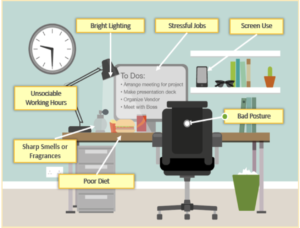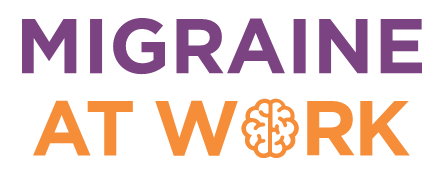Migraine health = Brain health = Overall health
How do migraine accommodations benefit brain health for all employees?
Sarah reports to her manager, Katherine, that she has been struggling to work with migraine. Sarah is an excellent employee, and Katherine wants to offer support to prevent Sarah from having to leave the company. However, Katherine knows relatively little about migraine and which potential measures can be provided. She worries that providing accommodations may be costly and may potentially negatively impact the productivity of other employees on their team. As Katherine researches, she finds that the opposite is likely true, and that these inexpensive accommodations may benefit all employees.
Where to start with migraine accommodations
It can be difficult to know where to start when considering accommodations for migraine in the workplace. If you are an employer, start with a personal conversation with the employee needing help to identify potential triggers and consider strategies which may help lessen that burden.
Remember that migraine is not a headache, but a neurological condition, and it can be classified as a disability under the ADA. It may help to know that implementing these accommodations is often an inexpensive, one-time cost, and that they can drastically reduce the overall financial burden in your office.
If you are an employee needing help, learn how to request workplace accommodations.
Migraine at Work can help ease this process. Reach out to us today for free or paid services to better support not only your employees with migraine, but every employee.
Migraine accommodations can benefit brain health for all employees.
One of the most interesting aspects of “migraine-proofing” your office is that many of these accommodations focus on improving brain health and performance. Consequently, there is a good chance these adjustments for brain performance and health lead to increased productivity and satisfaction from any employee, regardless of whether they live with migraine or not.
Migraine health = Brain health = Overall health
While our needs are individualized, there are many overarching principles to promote overall brain health. Simple accommodations can provide an environment that promotes overall employee health. In addition, these accommodations have proven to be largely inexpensive and effective.
This image below reveals potential migraine triggers that could arise from the office or home office environment.

Whether or not you live with migraine, chances are that several of these factors are unappealing to you, also. These triggers are not just slightly irritating. The presence of one or more of these factors can undermine overall employee productivity and reduce well-being. Research is continually emerging in this area and there is now scientific evidence to support many of these factors which are expanded on below.
Luckily, once these triggers are identified, it can be relatively simple to adjust and accommodate to maximize both production and employee satisfaction.
Here’s several accommodations or strategies to make your office more accessible for all employees:
1) Schedule Flexibility/ Remote Work Options: Migraine is an unpredictable disorder, and one may be given very little notice that an attack is about to occur. Like the ones highlighted throughout this article, offices may contain dozens of factors which may trigger or worsen a migraine attack.
Remote working allows employees to implement their own accommodations. During a migraine attack, employees may want things like blackout curtains, ice packs/ heating pads, and medications which may otherwise restrict them from being able to drive home after work. They can also avoid triggers such as odors, poor lighting, and excessive noise. Being able to adjust for these factors- especially within the privacy of one’s own home- can all lead to increased productivity and employee satisfaction.
With flexible scheduling, employees living with migraine are then able to work around their migraine attacks, and even take preventative measures to avoid the attacks from even occurring.
Before the Covid-19 pandemic, the prevailing belief was that working from home would erode productivity. The forced shift to remote work through the pandemic disproved this perception. In fact, many companies reported increased productivity. 1
The ability to work remotely and incorporate flexible scheduling has been proven to increase employee satisfaction and overall well-being. 2 These simple scheduling adjustments and teleworking options are critical for those with disabilities like migraine, but they also are likely to benefit all employees.
What accommodations can help this? Allow for permanent or intermittent flexible scheduling and remote work options. Give leniency for those with migraine to alert their managers without advance notice, as migraine often does not allow for advanced planning.
2) Proper Lighting Options: Photophobia, or light sensitivity, is one of the primary symptoms of a migraine attack. 3 A workplace can be full of different variations of light- overhead fluorescent lights, flashing lights of machinery, computer screens- which can initiate or worsen a migraine attack.
Likewise, people without migraine or light-triggered conditions are also affected. Do you notice yourself feeling drained after spending a few hours under your office’s fluorescent lighting? 4 Have you ever worked in a building with no windows and noticed your low energy levels? 5 The type of lighting in our buildings has been proven to affect alertness and productivity. 6
The brightness and color of light can impact our moods. 7 The ability to adjust our light for our personal workspace preference can lead to a boost in productivity, lift in mood, and a variety of health-related effects. 8
Similarly, too much screen time has been correlated to increased risk of stress, diabetes, obesity, anxiety, and issues with sleeping and eye sight. It has also shown a potential for reduced productivity at work. 9
What accommodations can help? Options include fluorescent light filters, incandescent lighting, and natural lighting. For screens, consider options like screen glare protectors, high refresh rates to reduce flicker, night shift/ warm screen options which are available through free programs such as f.lux. 10
While many people prefer natural light, curtains are a simple and inexpensive way to manage light when it’s too bright or bothersome.
Allow employees to have greater control over their lighting preferences to promote wellbeing and productivity. No one wants to be squinting at the bright screen or fighting the afternoon sunset directly in our eyes through the office window. Foster a culture where an employee wearing a hat, or light-filtering lenses will not feel uncomfortable prioritizing their own performance.
3) Sound Reduction Options: Phonophobia, or sound sensitivity, is also a symptom of migraine. 11 Offices contain a multitude of loud, piercing sounds- ringing phones, heavy machinery, overlapping conversations. This can be insufferable to those with migraine, and overwhelming even to other employees.
Some people work productively to background music or the open plan office chatter and calls. Others perform best with silence. When we aren’t in our favored sound environment productivity is compromised. Loud workplaces take a mental toll on many workers. 12 Excessive noise has been linked to a decrease in productivity, concentration, and communication skills. 13 It also can create health issues like increased stress, fatigue, workplace accidents, and other health issues. 14
What accommodations can help? Consider options like sound absorption panels or thick rugs and curtains to help dampen echoes. Provide noise cancelling headphones or earplugs for individual employees. Request that employees mute non-urgent sound notifications on email or text messages. Provide a quiet wellness room for employees needing even more audio protection.
4) Odor Elimination Policies: Osmophobia, or sensitivity to smell, is also a common symptom of migraine. 15 Triggering scents in an average office include perfumes, cleaning products, dry erase markers, and unfiltered air. Like with harsh lighting and sounds, scents can both trigger and worsen migraine attacks, as well as bothering employees living without migraine.
Our sense of smell is strongly linked to our memory. Scents in the workplace can negatively impact cognitive performance. 16 Odors can affect mood and even behavior. 17 Other conditions such as asthma and chemical sensitivities can also be triggered by seemingly innocuous scents, along with migraine. 18
What accommodations can help? Enforce a fragrance-free workplace where employees refrain from wearing any perfumes, cologne, or scented beauty products. The scents that calm one employee may negatively impact another worker. Do a clean sweep of any scented soaps, air fresheners, or cleaning products and replace them with unscented options. Install air purifiers. If an employee is particularly reactive to odors, position them away from kitchens, microwaves, trash receptacles, white boards, and other highly fragrant areas.
5) Stress Mitigation Options: Stress is a common trigger and exacerbating factor in migraine attacks. 19 Of course, few jobs are without any stress, and those with migraine are just as capable of handling reasonable stressors. Workplaces have an obligation, both to their employees and to their bottom line, to help mitigate unnecessary workplace stressors.
Americans are one of the most stressed populations worldwide, with 55% of Americans experiencing daily stress. This is 20% above from the global average of 35%. 20
Stress has far-reaching implications on both work performance and personal health. 83% of US workers suffer from work-related stress. Stress causes 1 million Americans to miss work each day, and costs US businesses $300 billion each year. 21
Stress negatively affects workplace measures such as productivity, presenteeism, employee turnover, and personal health measures such as memory, cognition, sleep quality, and overall life satisfaction. 22
What accommodations can help? There are numerous stress management strategies implemented in the workplace, including the tips listed in the other categories in this article. Ensure that there are meaningful changes to the corporate culture and not just stop-gap measures like a yearly massage or mental health day. Ensure the managing team is leading by example and cultivating a culture where mental wellness is prioritized. Learn more about stress management and mental health improvement strategies in the workplace.
6) Physical Comfort Options: Along with the psychological stress just addressed, physical stress is also a trigger, exacerbating factor, and symptom of migraine. 23 Poor posture, like that resulting from being hunched over a screen at work, can trigger an attack. 24 During an attack, those with migraine may experience pain in their necks, shoulders, and other areas of their bodies. For desk jobs, sitting in already uncomfortable positions may worsen an attack. In more physically active jobs, physical activity may exacerbate the pain and other symptoms of an attack. 25
Ergonomic office settings can help boost productivity and employee satisfaction in all employees. 26 As every individual is unique, find what works for your employees on an individual basis. Whether it is an ergonomic keyboard or a standing desk, there are many options to improve productivity and physical comfort. Taking breaks to walk or relax can increase productivity and problem-solving skills. 27
What accommodations can help? Provide employees options. Don’t assume comfort is one-size-fits-all. Consider standing desks, ergonomic seating options, and ergonomic keyboards. Encourage employees to take stretching/ walking breaks. Allow for remote work, which will enable employees to find optimal comfort levels to prevent and help relieve migraine attacks.
7) “Brain Break” Options: Attempting to be mentally “on” all day is unsustainable and can lead to exhaustion and migraine attacks in those who are susceptible.
Incorporating short breaks throughout the day can boost productivity, wellbeing, performance, and employee satisfaction. 28 They can help clear employees’ heads to provide clarity on issues they are trying to problem solve and prevent “decision fatigue.”
Dr. Culler explains, “A brain break should be purposeful engagement in a brief, meaningful exercise or activity and a ‘break’ from other tasks that require concentration and focus. Get up and move, do some light stretching, spend time with your pet, get outdoors, write in a gratitude journal, experience a good laugh, or read a poem aloud. Take multiple brain breaks daily and use these as a tool to prevent tiredness, frustration, lack of focus, or feelings of low mood.”
What accommodations can help? Create a culture where employees do not feel like they are under constant surveillance where they cannot take a minute to themselves. Encourage “brain breaks” throughout the day. Ensure that managers are leading by example and also partaking in these recharge periods.
8) Work-Life Balance Prioritization: Managing lifestyle factors like exercise, diet, and sleep can help manage migraine, as well as a multitude of other health conditions. If work takes over too much of an employee’s life, they cannot prioritize their health. As studies show, a decrease in quality of health also translates to a decrease in quality of work. 29
Long work hours and overtime can have dramatic effects on cardiovascular health; chronic fatigue and stress; substance misuse disorders; depression; anxiety; physical inactivity; poor sleep quality; and overall mortality 30 .
Long hours and overtime do not even help productivity. Findings have shown reduced performance and increased workplace injuries. 31
What accommodations can help? Do not force- either by mandates or simply peer pressure- employees to regularly engage in long, extended hours. Ensure managers are setting precedents for their employees by personally prioritizing work-life balance. Seeing this priority in practice can be more powerful than setting company standards which may not be enforced.
9) Healthy Dietary Options: Diet and healthy food and hydration choices can help with managing migraine. Dietary triggers may also contribute to migraine attacks. While these triggers are largely individualized, some common dietary migraine triggers include processed foods, dairy, and alcohol. 32 Fasting and dehydration are major contributors to migraine attacks in many of those living with migraine. 33
Even in those without migraine, it’s no secret that what people eat affects the way they feel. 34 Eating unhealthy food leads to a 66% decrease in productivity, and out of any lifestyle habit, a poor diet is the leading cause of death. 35
It is not always easy to eat well and hydrate properly while working in an office environment. If workers run out of time in the morning to pack a lunch, they may get stuck eating unhealthy break room snacks or picking up fast food. In order to avoid looking like they are slacking off and wasting time in the restroom, employees may risk dehydration by not consuming enough water.
What accommodations can help? Consider implementing longer lunch breaks and sponsoring healthy lunch and snack options. Allow for ample bathroom breaks for proper hydration. Remote working also empowers employees to manage these factors more effectively.
Key Takeaways
- Many accommodations for employees with migraine focus on brain health and performance. Migraine health = Brain health = Overall health
- What is good for employees with migraine may also increase the productivity and wellbeing of all employees.
- Accommodations are typically inexpensive and effective.
- Consider simple options such as options for flexible scheduling, telework, minimizing overtime and long hours, light/ sound/ odor reduction, ergonomic seating, stress relief, healthy dietary options, and both mental and physical breaks throughout the day.
- An accommodating office is a happier, healthier, and more productive office.


